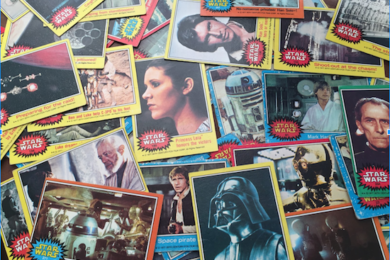I refuse to beat about the bush here. I was six in 1977, my parents had heard about this film getting all the hype and talk, it was just a couple of weeks after it opened, they went to see it and took me with them to a big screen theatre in San Diego, California, where we lived at the time, and that’s how I first saw Star Wars.
I was ruined for life and I have no complaints.
So getting that out of the way – as the fortieth anniversary hits, my reactions are equally "Wait I’m how old now" and "How wonderful to have been in on the ground floor of something." I mean, I just have some cultural pre-Star Wars memories kicking around, and I’m among the last generation (US, at least) that can say that. For everyone else younger than me, it’s just always been there, whether one film or eight (and counting).
That is, if you only care about the films.
Most people, strictly speaking, only care about the films, and that’s not only more than fine, I’d be a little unsettled if that wasn’t the case. (Tolkien is another one of my near-lifelong obsessions and believe me, I fully understand people who just want The Lord Of The Rings films and nothing else. Get down the rabbit hole too much, and, well, did I mention I can spell my name in tengwar?) But if you even lightly nerd out on the films, you learn about both the Expanded Universe (or EU for short, and make all the political jokes you’d like) and the new post-Disney Star Wars canonical universe as such.
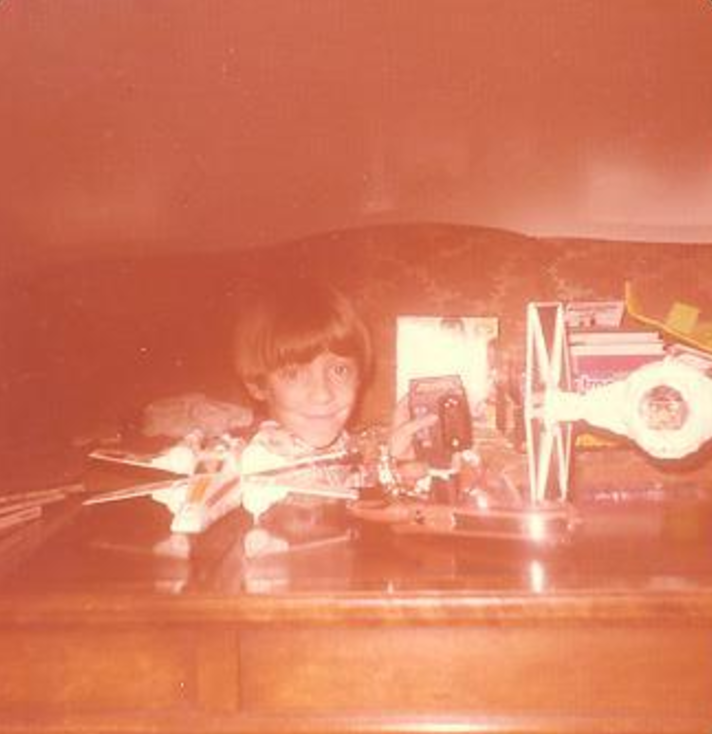
For this photo, you can thank my parents. I should admit – I’m actually holding a Battlestar Galactica game
Under George Lucas there was a somewhat ad hoc but increasingly regularised overlapping series of canon material – with the films at the core, the ‘real’ work as such, everything else issued under some kind of official license was eventually termed the EU, whether books, comics, TV series, games, etc. None of this extra material was seen by Lucas himself as anything but addenda to the films, nor did he much treat it as anything more. This had been ticking away for a bit but really roared into public attention here when Timothy Zahn’s Heir To The Empire novel in 1991 provided the first sanctioned "and then what happened?" answer to the end of Return Of The Jedi eight years earlier, and ranked high on bestseller lists almost out of the gate. Over the next twenty years, with the prequels adding even more backstory to work with, a huge volume of such material was created.
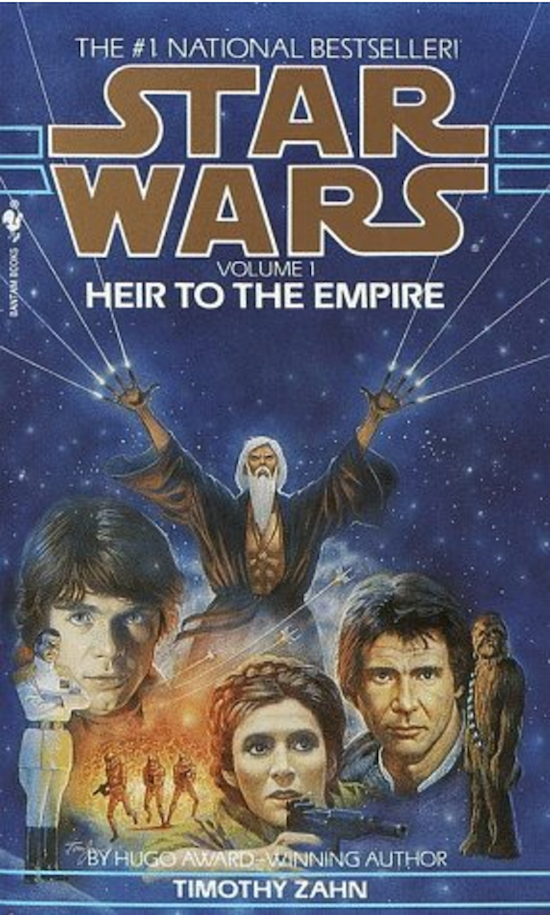
Via Wookiepedia. Yes, it’s an evil Jedi with abs and, apparently, long fingernails. It was 1991. So… grunge?
When Lucas sold it all to Disney, the combined movers and shakers there and at Lucasfilm decided to hit the reset button hard – everything that had come before aside from the films themselves and The Clone Wars movie and TV series was rendered uncanonical (though helpfully repackaged via the ‘Legends’ rubric), but everything to come under the Star Wars banner following the sale was explicitly canonical. The films retain primacy by default, but with both Lucasfilm and Disney having proved themselves experts in the realm of ancillary material on top of their original film businesses, it was a chance to go whole hog. Yet more novels, TV shows, games, comics, only this time whatever happened in them not only had to refer back to the films old and new, but fully reinforce them, and vice versa. This has already played out any number of ways and will doubtless continue for the near future and well beyond, especially as Hollywood now seems to be fully reorienting to the endless franchise era – and it’ll only stop if the money does.
But I’m here not to write about where this expansion has all ended up, but where it started, from my perspective at least. Strip everything away about what we know has already happened, the multi-generational success story of the whole shebang, the increasing omnipresence in popular culture as defined, the fact that the Star Wars universe/franchise/whatever you want to call it is, exists, and continues to exist on a worldwide profile, and take it back to 1977 and me having seen the film at least a couple of times. (I’m sure I would have gone every day if I could, but there’s only so much you can do when you’re six.) Word eventually seeped out that another film, at least, was coming, and that was great… but that was a while away. Until then, what? Because I really wanted to know what else was going on in that universe.

Via TheForce.Net‘s poster database
It’s not that there weren’t ways to push for and celebrate straight-up fandom of the original film, things which, in the absence of widespread VCR use of any sort, were the only way to revisit the film constantly without simply being in a theatre or relying on memory or games with your friends. Some of this early material has already passed into subcultural folklore – for instance, the original Kenner set of model figures, delayed for some months and only available for Christmas purchase that year as, essentially, a display and a promissory note. (I did eventually get my set.)
There were the trading cards that rapidly began circulating, and which I ended up getting a large number of. My collection is still in my desk drawer – same antique family desk I’ve used since around that age – and I mostly have selections from the blue, red and yellow ranges, plus some of the green and a few orange ones. There was both the official John Williams soundtrack double vinyl – my mom playing that when she got it remains one of my key earliest musical memories in turn, separate from the overwhelming audio/visual punch of actually viewing the film – and The Story Of Star Wars, a convenient, redacted summary of the film on single vinyl featuring music and dialogue cues throughout the film as well as a narration by the great American actor Roscoe Lee Browne.
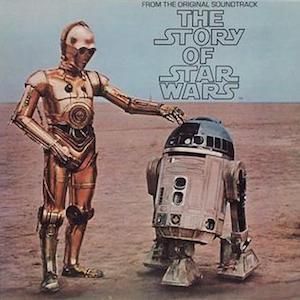
Via Wikipedia
There was also both a film storybook and a comic adaptation of the film, the former featuring a variety of set and publicity stills along with a brisk retelling of the story. The latter was the famed comic adaptation by Marvel, spread out over six issues and then republished in various omnibus ways. I had – and, somewhere, still have, because I’m not crazy enough to have ever thrown it out – a large, 10" by 14" book, something I remember picking up in 1978 via a family visit to our local Toys ‘R Us shop. I remember feeling like the book seemed almost as big as I was – sure an exaggeration, but when you’re young and so forth.
Written by Roy Thomas and pencilled by Howard Chaykin, it was a vivid way to be introduced to 1970s top level American comic art as much as it was the film all over again, and even though the original film is the core, I read and reread that comic version enough over the years before finally owning the film on video that some of its own beats, angles, approaches and so forth are to my mind as central as the film, maybe even a hair more so.
Funny thing to my mind about both the film storybook and the comic, though, at the time – they had all this other stuff in them. Some of it was in both, some of it was only in the comic. But both showed Luke down on Tatooine well before the Jawas arrived with the droids, observing the Star Destroyer/Blockade Runner battle in the sky, rushing to tell some friends (who thoroughly mocked him) and running into an old friend, Biggs, who later told him he was planning to join the Rebellion. Later – in the comic book version only – there was an interaction between Han Solo and Jabba the Hutt outside the Millennium Falcon, Jabba being a tall green-skinned alien humanoid who was a little annoyed that Han did, in fact, shoot first.
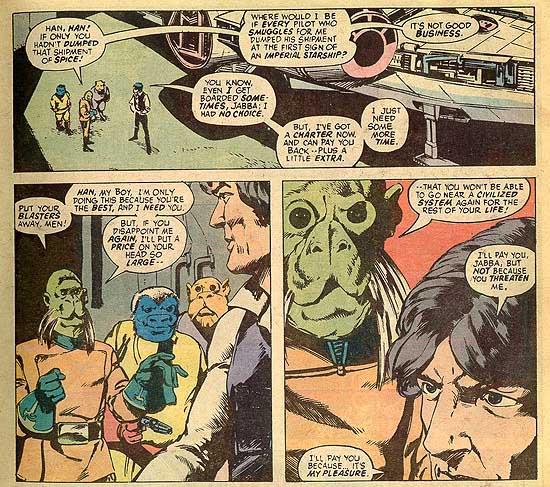
Via The Secret History Of Star Wars
It was, in retrospect, a wonderfully unexpected way to be introduced to the fact that there are cut scenes in films, that a film is shaped as much by editing as anything else, that what we see on the screen isn’t necessarily what might have been originally intended. The Jabba scene, with late 1990s CGI effects, was included in the 1997 rerelease/special edition of the film; the Biggs scenes, along with other shorter cut or alternate scenes, surfaced elsewhere, most recently in the formal Blu-ray set of the six films done before the Disney sale. At the time, though, what they also told me, a little confused but very intrigued, that there was definitely ‘more’ out there, somewhere. More story, more… something.
If I had been lucky, I would have known about the comics more thoroughly that followed those original six issues. I was maybe a little too young and unsure where to go to get them – if I had been, say, ten, probably a different story. But, sporadically, I got to sense that in fact there were more Star Wars comics out there, and they were telling some strange tales. If the newspaper my family subscribed didn’t have the comic strip (which formally started in 1979) and if I wasn’t noticing best where to find comics, or Star Wars comics in particular, that’s the breaks.
So I gathered that some form of continuing adventures were happening with Luke, Leia and Han and everyone else, doubtless with Darth Vader being annoyed at them for several good reasons. The one thing I DO remember, though – whether from a cover appearance rapidly glimpsed or somehow flipping through a copy of an issue a friend might have had (no, I don’t know why I didn’t ask said friend where I could get them myself) was the rabbit.
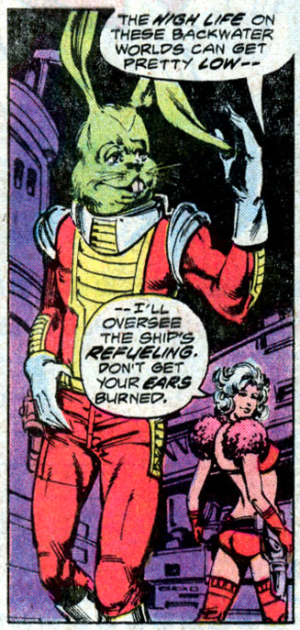
Via IGN
Now keep in mind another – quite healthy, if you ask me – childhood obsession was cartoons, meaning especially the classic Warner Bros. run that endlessly recirculated on most weekday afternoons and on Saturday mornings. So I was down with Bugs Bunny and all, and so seeing a tall humanoid rabbit dealing with other humanoid types in Star Wars settings seemed understandable enough on the one hand. On the other, I’m sure I was also thinking “…a RABBIT?"
Turns out that Thomas and Chaykin created this character for issue #8 – just two issues into their fully original material after the film adaptation – specifically as a Bugs Bunny homage, and that his name, Jaxxon, is also a Bugs reference. (Just go to the ‘Behind the Scenes’ section here if you want to know more.) From this distance I am totally fine with Jaxxon; at the time I might have been a little more unsure but hey, space rabbits, you know, bring it on. If anything it speaks to the sheer fluidity and unsureness of what Star Wars could mean, and I think that’s deeply to its credit. A universe that, in its original foundational document – the 1977 film itself – had a visual joke involving a Wookie settling down into a spaceship cockpit while knocking into the equivalent of a pair of rear-view-mirror dice is not a universe where everybody and everything is po-faced and serious 24/7. (Do I even need to mention a swing-style jazz band grooving at a bar?)
And while I’m certainly not positive I read this at the time, this two panel bit from that issue Jaxxon first appeared in might just be my favorite EU-related anything Star Wars ever did, courtesy this Brett White Comicbook.com article from a couple of years back covering said issue:
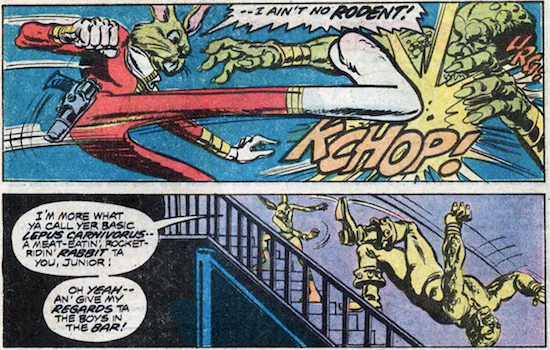
I mean, come ON. If you don’t like that, I can’t help you. If Jar-Jar is by default canon, Jaxxon is hypercanon as far as I’m concerned. (And when you consider that what might be the original film’s best spiritual heir, Guardians Of The Galaxy, made the idea of a rough and tough talking raccoon part of the wider lingua franca beyond its core comic book audience, I am so ready for a standalone Jaxxon film.)
Besides, about a year later there, fall of 1978, was something else completely separate that made Jaxxon seem somebody totally buttoned down and completely normal. I was SO excited for it, I remember being stoked. Getting to see all the characters again, new adventures, and I didn’t have to go anywhere for it! And it wasn’t until almost fifteen years after that, when I was sitting in my grad student housing one evening idly thinking about whatever, that I went “Wait… I saw that, right? That did actually happen? Is it… just… not around?"
It gives you an idea about how my fandom isn’t anywhere near the level of others that The Star Wars Holiday Special completely disappeared from my brain during all that time. Now, of course, it’s a spectacular legend of serious WTF, a bizarre cross between the terrible plague of 70s variety show specials that American TV seemed addicted to and, well, Star Wars. Never officially rereleased, widely and constantly circulated online thanks to whoever copied it off the air to start with, it almost doesn’t need to be talked about much at this point except to regard it with a jaw-dropping or chin-scratching awe.
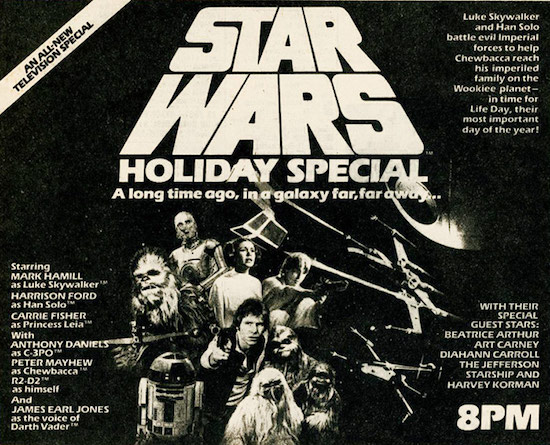
But to return to my earlier point – this blank slate of a universe could, theoretically, have anything or everything in it. (And it’s maybe a little late in the essay to say this but yes, of course it’s a cultural product of its time, place, society etc. and that causes all these points of reflection and connection to happen as they do, so take that as read.) So: trying to ‘make sense’ of the Holiday Special in the wide scheme of things is one thing. How did it make sense to seven year old me, though? It made plenty of sense! Sure, plenty of jokes and references I didn’t get or wouldn’t’ve gotten – first time I had ever heard about Jefferson Starship, say – or things that just seemed off, like the little holographic circus or the fact that the one old Wookiee was being weird about Diahann Carroll. Again, I’m seven. There’s a lot I just don’t know yet.

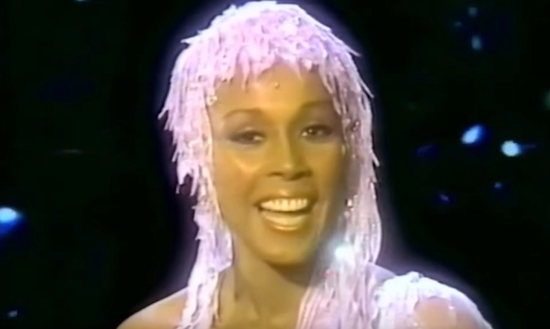
Via Empire Magazine, and some unutterably perverse place
However cheap or clunky the Special looks now, though, there was enough meat to it still for me at least. A visit to Chewie’s home planet, a strange forested location? A home high in the trees? Evil stormtroopers on the hunt for him? Han along for the ride? Leia appearing, Luke beaming in by remote message? I mean, there they all were, it wasn’t like this was other actors replacing them or anything, it had to be real, a new adventure! No, no big Death Star explosion at the end, no more hints of the Jedi or anything much like that, but there were weird aliens and space sequences, that worked for me.
There was also the cartoon. The cartoon’s weird in the context of the special – it implies Chewie’s son Lumpy was watching a cartoon series telling about an adventure that happened to all these characters recently. Then again, when you think about that Taiwanese news outfit with their CGI summaries of recent news, maybe this is just that galaxy’s version of it. But the cartoon’s the only bit from the Special that’s ever been treated as legit since, even appearing on that previously mentioned Blu-ray set. It’s a straight up miniadventure, could have easily been a comic book issue, say, with weird semi-liquid planets and strange monsters and a cryptic peril facing Han – and, even more importantly, it debuts Boba Fett.
Even more so than in The Empire Strikes Back – where, to be strictly honest, all he does besides figuring out how to follow Han and Leia to Bespin is just stand around, ask Darth Vader a question or two and answer a couple of points in turn, fire some shots at Luke and then fly away with Han – Boba fully acts like the resourceful badass he’s supposed to be. He appears riding some truly strange dinosaur looking thing, wheedles himself into the confidence of Luke, surreptitiously gets a hold of Darth Vader – a moment I vividly remember when I originally saw the Special – and, when his plans are exposed, gets away with a blastoff via his rocket pack. Now that’s show business, and I could have hardly been the only one wanting to see more of him.
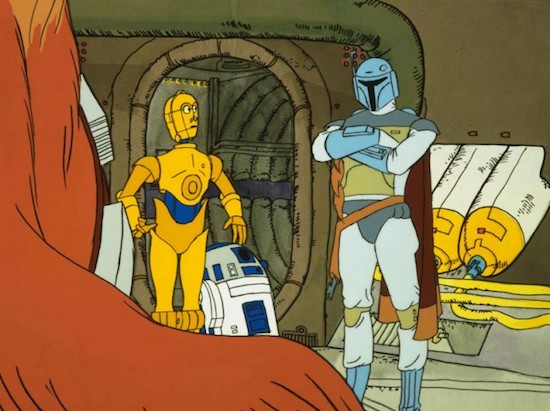
Via Boba Fett Fan Club. Don’t ask me why C3PO’s eyes are like that
1979 brought a bit more to work with – there were a few kids’ books that appeared, mostly illustrations, and aimed squarely at people like myself. This article talks a bit more about a few of them that I had, including The Mystery Of The Rebellious Robot, with some wonderfully weird and fun illustrations of our heroes and further proof that Jawas just aren’t up to any good sometimes, and the Darth Vader Activity Book, which also serves as a reminder that whenever people say Rogue One made Vader scary ‘again,’ arguably he had ALWAYS been a figure that made it fun to be scared. Sure, the famed confrontation in The Empire Strikes Back made him even more tragic and unsettling – I remember I felt pretty screwed up watching it – but when you’re making Death Star cookies from ‘his’ activity book the year before, it’s not like he’s a self-serious goth all the time. (And indeed, being interested in cooking already, I helped my mom make a few Death Star cookies around then. They were delicious!)
But perhaps the one I liked the most was The Maverick Moon – from this distance, it’s a very strange story, featuring only Luke, Leia, C3PO and R2D2, having almost nothing to do with anyone or anything else in the original film, and basically boiling down to Luke, now an academy pilot somewhere (Empire? Rebellion? Who cares?), using both his X-Wing and the Force to blow up a rogue moon that’s about to crash on said academy’s home planet. So, Armageddon, without Bruce Willis or animal crackers. Yet even in its randomness I remember loving it and rereading it often – the art was vivid and strong, it told a tense story, and while it felt a little ‘off’ in terms of how separate it was, I still treated it as, well, real, in the story’s timeline, though I can’t say I was formally working out how. If on the one hand looking to expand what kind of stories can be told is freeing, there’s also a kind of understandable sense – especially, but not solely, limited to younger participants in a creation like this – to systematise everything, to explain things so they make sense, even if only to oneself. What strategies I employed I couldn’t tell you, but I worked on them.
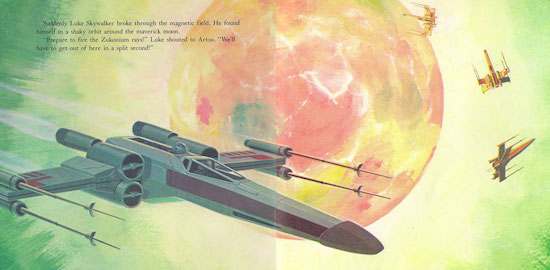
Via Jordan McArthur’s Tumblr. That’s one weird moon
1979 also brought the start of what would soon become a complete trilogy well before Return Of The Jedi appeared four years later – Brian Daley’s books about Han and Chewie’s adventures before meeting up with Luke and Obi-Wan in that cantina. That trilogy finished up soon after The Empire Strikes Back was released, so I’m looking ahead a bit, but having the three paperbacks packaged together in a box was something that was a key element in my bookshelf for many years, it’s all a bit inextricably tied up with that time, as the core movie turned into the start of a trilogy, as it all formally got a bit bigger.
That said I’m pretty positive I tried to at least start reading the first book, Han Solo At Stars’ End, when it came out in paperback in late 1979, so I’ll count all three of them in with this remembrance – and rightly so, because in many ways Daley was a key figure in how Star Wars could be, indeed, expanded outward, or in interesting directions. (He also served as the prime force behind the formal adaptations of the three original films for radio productions in the 1980s and 1990s before sadly passing away due to pancreatic cancer – productions which each expanded beyond the films’ narratives to include extra background or character development.) He’d already made a mark with a couple of books of his own before working on the Han Solo books, with his two Coramonde stories showcasing a love of already then-classic tropes and an eye for 1970s wryness and weirdness. In many ways, he couldn’t’ve been better for the job.
But again, take it back to where I was in 1979 – I didn’t know any of that, all I knew is that there were some Han Solo stories starting to come out, and if I didn’t recognise the name Brian Daley anywhere, hey, it’s Star Wars. It’s a little weird, maybe, that I gravitated more closely to formal novels rather than, say, the more immediate textual/visual combination that comic books provide, but that I think has a lot to do with my own there-and-yet-not interaction with the latter medium on all levels over the years. What’s great about the three novels – even if I didn’t fully grasp everything on an initial encounter – is how Daley immediately caught the ease of Han Solo’s thoroughly uncomplicated character from the original film: the rough figure with the heart of gold. Harrison Ford perfectly sold him in the films, of course, so projecting him back into novels wasn’t hard at all with a role model like that – we all already knew how Han would look, talk and act. (Chewie too, obviously.) The rest was easy.

Via But Is It Canon?
That said, if the novels were just Han Solo showing up places and going “Hey, I’m Han Solo," that wouldn’t be much of a story. But Daley had all he needed to run with from the original film itself, in response to Luke’s wondering if Han believes in the Force:
“Kid, I’ve flown from one side of this galaxy to the other, and I’ve seen a lot of strange stuff, but I’ve never seen anything to make me believe that there’s one all-powerful Force controlling everything. ‘Cause no mystical energy field controls my destiny. It’s all a lot of simple tricks and nonsense."
Pat dialogue for a character type, but Ford as noted delivers it in grouchy comfort (with Alec Guinness’ content ‘if you only knew’ smile to the side of the camera frame his own form of one-upsmanship), and Daley further delivers on just that promise. Not only is the Force not a factor, but the Empire and the Rebellion aren’t either, except as backdrop. Han and Chewie get themselves into scrapes and get themselves out of them, earn big and lose big, almost lose their ship, their lives and each other at several points, and there’s always the sense that even more stories exist as further background, as alluring and weird as Sherlock Holmes’s unrecorded cases.
And if it’s not conceived as a classic trilogy per se, it’s not just a picaresque series of adventures either. Each book – Stars’ End, Han Solo’s Revenge and the Indiana Jones-before-its-time concluding title Han Solo And The Lost Legacy – has its own key story, each one building on the one before it in some distinct sense. Instead of the Empire as the main ‘big bad,’ there’s the Corporate Sector Authority, a subset or local government within the Empire that gives Han enough headaches as it is, and the first two books deal with said results. There’s crusty outlaw technicians (and their flirtable-with outlaw technician daughters, as Han discovers in the first book), corrupt officials and the occasional on-the-line ones, evil wardens, faithless slavers, good-hearted if doomed characters who can speak Wookie (much to Han’s surprise), breathless escapes, improbable but wildly enjoyable pursuits on, around and through planets and much more. Any book series that contains both a last-minute workaround to get away from a prison complex that’s been temporarily blown into space before it crashes back into a planet as well as heroes feeling a little down in the dumps because they’re stuck doing legitimate work showing documentaries in lieu of any other option – I am not kidding about that, by the way – is a real treat.

“I gotta do what?" Via ReadStarWars
Again, not that I really knew about how much of this was simultaneously classic pulp from many different sources – adventure tales, hard-boiled mysteries, and of course famed SF stories straight up among others. But Daley had a gift to play around in the space which Lucas had synthesized and then opened up to others, and he went for it. In the process he created more than a few memorable characters as well, maybe less visually distinct than Jaxxon, but no less part of the crazy shebang. In the first two books Han has a light romance in turn with Jessa, the previously mentioned outlaw technician, and then Fiolla, a government official out to expose corruption – neither femme fatales nor doomed victims, they’re competent characters with their own wits and attitude that Han openly appreciates.
In all three books, Han and Chewie had their own pair of droids accompanying them, Bollux – renamed Zollux in the UK printings for fairly obvious reasons – and Blue Max. While obviously inspired by the C3PO/R2D2 partnership, Daley’s riff on these two took them different directions, with Blue Max being a small functional blue box often carried around in the humanoid Bollux’s torso, and with Blue Max coming across as a chipper and adventurous young kid while Bollux was more of an old, worldwise worker. It’s a nice change up and the humor plays out in different fashion as a result.
Then there was the Boba Fett before Boba Fett, in a way – Gallandro, a swashbuckling yet emotionally cold, visually distinct character reputed to be the galaxy’s best gunslinger. I say visually distinct because I always remember when I first read about how he had long mustaches, each with a gold bead, combined with a wardrobe emphasizing both flair and his own skill. Again, a character of a type, but also again, a perfect type to set against Han’s perfect type, and when you read him you almost wonder who would be the perfect actor of the time to cast against Ford if they had ever filmed these. (My vote? Warren Oates, easy.) He’s contrasted clearly enough with Han so you know he’s the bad guy – definitely no heart of gold, and a lot more joy in killing, or at least a lot more of a rush of energy – but Daley makes him compelling so he’s a really interesting bad guy.
First encountered in the second book – and outsmarted at the end of it by Han – he comes back in the third, Lost Legacy, on a mission, and the book builds to a classic showdown that, if it’s not quite, say, Shane, may not be too far off in its own way. I also mentioned Lost Legacy as being Indiana Jones-like as well, and that’s not just in the title – the Macguffin for the story is a lost treasure horde of an ancient galactic tyrant, and said showdown demonstrates that while Gallandro may have the power of the draw in the end, Han demonstrates in turn that having that heart of gold and a knack for the right friends and allies doesn’t hurt either.
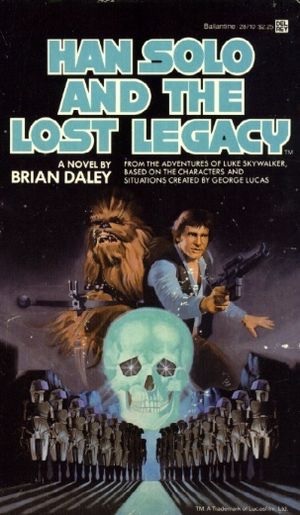
I mean, this story even had a crystal skull. Totally a secret forerunner to Indiana Jones. Via Star Wars Reading Order
Daley’s Han Solo books remain, for both nostalgia and for their easy joie de vivre, going off in their own clever directions within what had been initially established and unburdened by what would eventually become the big wave of interconnected material following Zahn’s 1991 success, my own personal favorites of the entire initial cycle. I have a not so secret hope that the forthcoming standalone young Han Solo movie, which by default will be the ‘real’ early story of the character, will have some of that feeling to it.
But I’ll conclude on what for me was almost the mystery story of the time, the one that was both exciting and really, really weird, the actual first novel in what became the Expanded Universe, published in 1978. I forget how I first heard about it but, setting aside the Marvel Comics series and, in its own way, the Holiday Special, it was the first actual legit ‘new’ story following the original film, and it didn’t hurt that it had an absolutely compelling, unsettling bit of cover art to it, created by famed concept designer Ralph McQuarrie, whose pre-production illustrations helped define the look of all three original films. The story was Alan Dean Foster’s Splinter Of The Mind’s Eye, and it remains the road not taken for what Star Wars as a whole might have become.
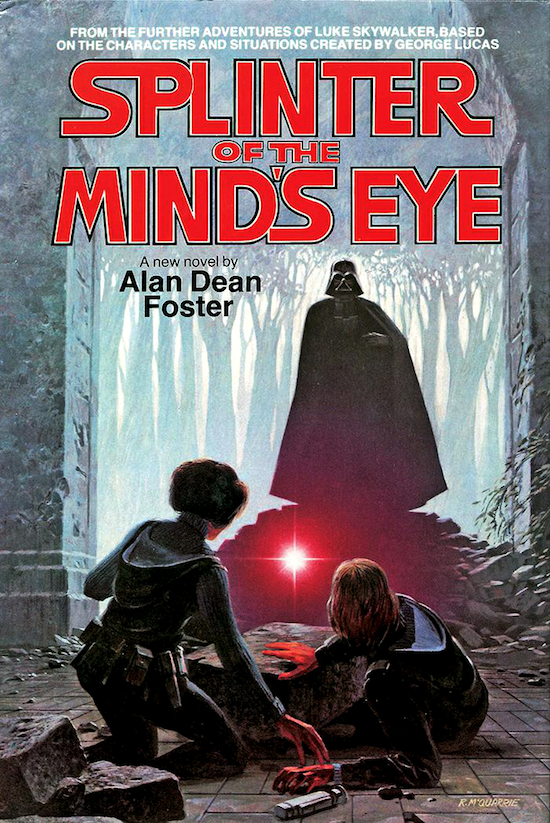
Via Wookiepedia
When I say ‘road not taken,’ it’s due to what wasn’t widely known at the time when it was first considered. In this feature story from 2005, Foster gets a well-deserved section to talk about both his involvement in ghost-writing the original film’s novelization for Lucas (in the previous few years, Foster had already established his own reputation with both his own SF work as well as various SF-related novelizations) as well as helping create what, in essence, was planned as the fallback. If Star Wars bombed or simply didn’t do as well as expected, leaving Lucas in control of a property that wouldn’t get much in the way of studio or financial support, he wanted to be able to film a sequel on the cheap, something that could be done with existing props and costumes, a sharp move all around.
Of course, what happened happened, and Lucas instead found himself worrying about properly following up the original film on as grand if not grander a scale in numerous ways. But with the contract in place and no reason not to go ahead and try out the novel anyway, Lucas and Foster went for it, and the result was Splinter. Per the Foster interview, the story’s original conception had other limiting factors – neither Ford nor, it seemed, Chewbacca’s performer Peter Mayhew had fully signed on for sequels yet, so the story couldn’t include them. (In a way, this made Daley’s Han Solo books the perfect counterpart in turn.) With that as a guide, Foster wrote a story that was very much Star Wars, but a Star Wars that was at once smaller in scope, one that was also very unusual and unnerving.

It’s probably Emo Kylo Ren’s favorite Star Wars story. Image via ET Online
Set on only one planet, Mimban, it starts with Leia and Luke, accompanied by C3PO and R2D2, being forced to land there while on a diplomatic mission (sounds familiar!), leaving them to figure out how to depart as quickly as they can. Said planet is all murky, fog-bound jungle, though it turns out there’s a secret Imperial mining facility there which our heroes infiltrate to see what they can do for themselves. At a bar, they pass themselves off to some stormtroopers thanks to a handy change in clothes, but also encounter a strange old woman, Halla, who claims to have a connection to the Force and speaks of a mysterious relic connected to it as well, the Kaiburr crystal, which she has a shard of, that she is looking for at a lost temple somewhere on the planet.
From there the story unfolds as everyone plus Halla and two friendly Wookie-like creatures from another planet, Hin and Kee, either evades or escapes from Imperial pursuit and imprisonment while beginning to search the planet for said temple. Strange beasts, unfriendly environments and native tribes and more all crop up, building towards an expected enough end where the temple and the crystal are found – except that Darth Vader, having heard that Luke was on the planet, is heading there himself.
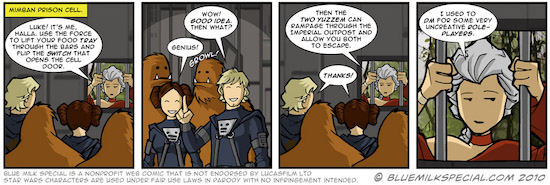
Actual plot point as recounted via Blue Milk Special. Except for the DM/roleplaying bit
It may be modern cant now, but saying spoiler warnings apply from this point forward makes a good amount of sense, because Foster’s ending is truly one wild ride. But to set it up before that – Splinter isn’t a success so much as it is a true curiosity, with sometimes inconsistent connections to the original film. Foster’s a solid journeyman rather than a standout writer, not always the best stylist, and makes some choices throughout that aren’t exactly the happiest in retrospect. Leia, in particular, gets rather ill-treated throughout the book – even slapped by Luke once, in an attempt to fake out the stormtroopers mentioned earlier. If Foster’s novelization of the original film was by default partially locked down to what Lucas had created, the freer range here, resulting in both Lucas’s original restrictions and then the realization that the book wouldn’t have to carry the burden of being the story for an actual next film, results in a distinctly creepier atmosphere as the story progresses.
Some of that atmosphere should ring familiar, granted. Mimban’s fog-bound jungle existence, Halla as a seemingly wise if eccentric figure with a connection to the Force, and a mysterious Force-powerful location that also has murky black holes to nowhere – if you’re thinking Dagobah and Yoda in The Empire Strikes Back right now, you’re not far gone. (There’s even a band of proto-Ewoks, looking even further ahead.) Yet think of this not as the first draft of all that, but a different approach entirely, further shaped by Foster.
Mimban’s half-glimpsed creatures often seem more intently malicious, the direct presence of the Empire adds its own sense of problems, and there’s a real sense of desperation at work as the story progresses. If Luke on Dagobah is frustrated at his own crashed ship, he’s not actively hunted – definitely not the case on Mimban, where not one but four of the original film’s heroes seem like they’re going to get it bad more often than not.
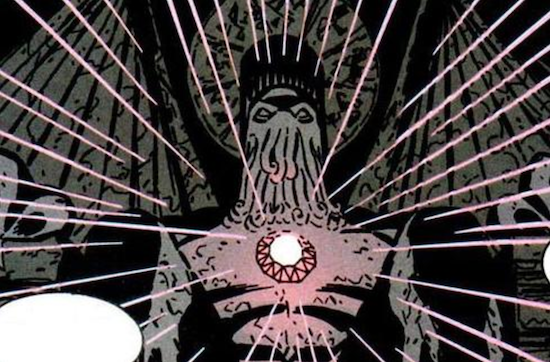
Did I mention that the temple with the crystal in question is dedicated to a god of insanity that was admittedly based on Cthulhu? Via Wookiepedia
In fact, that IS what happens. Darth Vader kills not only the Imperial mine’s commander – par for the course perhaps, but remember, The Empire Strikes Back was still two years away – but takes out Hin and Kee, deactivates the droids and crushes Luke’s leg under temple rubble. Which leaves Leia, alone, to take Luke’s lightsaber and fight Vader, as initially shown in that arresting cover painting.
When all is said and done, Leia has been terribly injured by Vader and is unconscious, Luke, rescued by the dying Hin and drawing new power from both Obi-Wan’s spirit and the Kaiburr crystal, fights Vader directly, but pushes himself to the point of exhaustion, and at the last Vader seems to have the victory but stumbles and disappears into a dark well. While Luke is able to heal Leia and they, the droids and Halla make their way at the end to leave the planet, it’s a much more brutal, unusual ending all around in comparison to the original film, and seems of a piece with the dark, almost paranoid feeling of much of the novel. One can easily see how it could have been filmed as a sequel to the first film if needs arose, and it’s not like The Empire Strikes Back has any less of a rough, uncheery ending, but the cinematic sense of it in my head is less the first film’s giddiness or even Empire‘s striking colors and beauty and more the strange weirdness of some of Tom Baker-era Doctor Who serials, or even the kind of stories featured in Métal Hurlant or its English language equivalent Heavy Metal. Even Vader’s disappearance, however much it seems like a classic serial ending (he’s dead…or is he?), feels more cryptic and not at all reassuring than convenient.
To top it all off, there’s this in retrospect amazing detail from Luke and Vader’s duel in turn – when they fight, much like the ‘real’ first fight in The Empire Strikes Back, a limb is severed. But it’s Vader’s – and he then switches to his other arm and continues to press the attack.
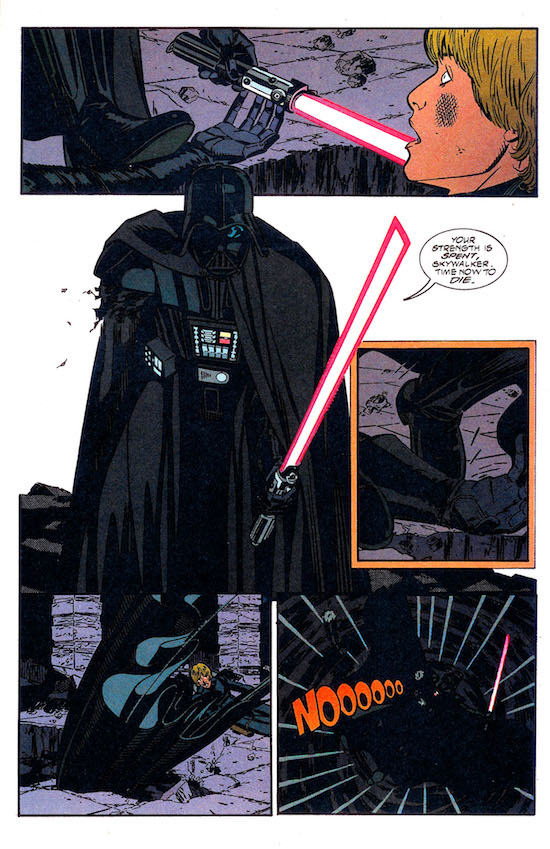
If I had seen this in a film at that age I would have freaked the hell out. Via Blue Milk Special
Reading all this when I was seven and eight – or trying to, I freely admit, I skimmed here and there – was a bit of an eyeopener, to say the least. My memories of the story at that time are of intrigue and confusion, how it didn’t really feel like anything I’d quite read up until that point. Sure, at the end, our heroes happily survived and were off to their next adventure, but they had gone through some rough times in a strange place. It could have been that I was simply too young to properly frame it all in my head, I’ll grant, but the lingering impact of Splinter as being this outre tale, one that fit into the larger story as it evolved but had its own odd, queasy taste to it, echoed down for many years. It still has a cult following, having received an official comic adaptation twenty years back, and very much has a pride of place as the first real Star Wars novel. But I’m not at all surprised it didn’t set the tone for what followed.
You can’t go home again, to quote the literary canard, and there’s no way that wild and weird time between the original film and Empire will ever exist again, when so much of what Lucasfilm seemed to be up to was a ‘throw it at the wall, see what sticks’ approach – something I couldn’t blame them at all for doing, given Lucas’s own primary concern at expanding his companies to properly do the following films, always his key goal, as he desired. Nothing at all quite existed like that before, a franchise and a universe emerging out of nowhere, however many antecedents Lucas had drawn on to create his initial film, and the further results went from hackneyed TV comedy to grimy, horrific duels and back again as people worked from a particular template however they chose.
Personally, I thoroughly admire the current Star Wars universe as a now vast and evolving project across multiple media – it’s a fascinating combination of art, commerce and how to explore what’s become a legacy, and I haven’t even touched on what fan creations bring to the sphere in turn. For a while there, though, in the mind of a young kid, among many other fans, Star Wars wasn’t just everything, it really was anything and everything. More power to it for that reason, and here’s to whatever the next forty years brings.


